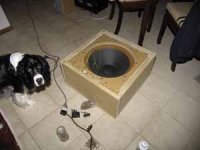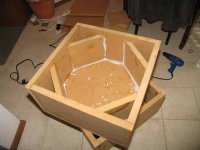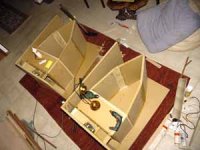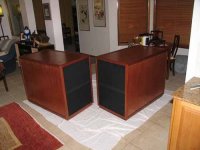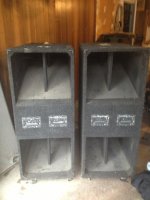Sorry to dig up an old thread, but I have a few of the 2nd design genuine Universal Studios Sensurround Earthquakes for sale. I bought them thru Clark Stewart back ~1986, when he was the property manager of Universal.
They measure 48" X 48" X 20", and have a single 18" driver. I also have a set of the mouth extenders, so I have the dimensions of them.
These were used in a movie theater in Tuscon, AZ. It was a medium-size theater, so they used 8 subs. I had to buy all 8--still have 4 left. I also had to buy 2 of the huge original ones that used 2 ea. 18" drivers, but I sold them years ago.
Please see my ad in the For Sale section. The subs are located just west of Phoenix, AZ.
They measure 48" X 48" X 20", and have a single 18" driver. I also have a set of the mouth extenders, so I have the dimensions of them.
These were used in a movie theater in Tuscon, AZ. It was a medium-size theater, so they used 8 subs. I had to buy all 8--still have 4 left. I also had to buy 2 of the huge original ones that used 2 ea. 18" drivers, but I sold them years ago.
Please see my ad in the For Sale section. The subs are located just west of Phoenix, AZ.
I'm also sorry for severe necromancy but figured why start a new topic when an old one is just as good. >_> I actually have a specific interest in Sensurround though as recreating comparable levels at home was one of the design goals of my eventual IB/floorhorn system.
Two things I was curious about, any suggestions for the modeling of the physics of "horn extensions" whether the ones used for the Sensurround horns or other horns? For instance, until I build up the IB system I expect to use smaller horn subs. (not quite Sensurround but to be honest, this is the only place I so far have ever heard of "horn extensions" even being discussed) If I build extensions to put onto existing horn subs, would it improve low end frequency response, or sensitivity, or does that depend entirely upon the design of the hornsub? (ie does it have to be designed originally to expect/need the extensions, perhaps the Sensurround horns specifically require them)
The other question, and the reason for posting on this forum... can anyone specifically familiar with the original movie Earthquake, or the Sensurround Model _1_ box PM me? My only current information is here Sensurround - Wikipedia, the free encyclopedia :
Surviving equipment
The last two known original "Sensurround Model-1" control boxes are owned by Dolby Laboratories. They are loaned on occasion for revival screenings of films using the process. At least one replica system exists, as it was custom built for a 2004 London revival screening of Earthquake. Sensurround Mod-II and Mod-III boxes are extremely common and relatively easy to find from old theater equipment dealers and can be bought for $50 or so. The Mod-II and Mod-III boxes were mostly just modifications of the original control boxes, but the changes are not easily undone to make them capable of running "Earthquake" because MCA did all the modifications themselves and never released any documentation about the changes made to each circuit card in the unit.
I would like to possibly get in touch with whomever built the replica for the 2004 London revival, or some fan-group that might know about it, or whether anyone has ever reverse engineered or has schematics of the original box with the intent to possibly back-convert a Mod 2/3 box to original "Earthquake" configuration. (OR the possibility of coming up with say a software simulation of the same process - which shouldn't be hard, "random" isn't too big of a deal, right? It just would be nice to maybe try to fine tune the process.)
This actually relates to my desire to create a Fan Restoration featuring proper generation of the bass signals into the LFE channel (and removal of the control tones which were AFAIK not meant to be played?) so that anyone (who bought the movie of course) can get the fanedit and burn a Bluray with "proper" Earthquake sound. Since the Mod 2/3 boxes are commonly available, buying one used and using that to record the bass for the other Sensurround titles and remaster the audio can use real hardware, the trickiest feature is... the original Earthquake.
(now maybe people are starting to see why i'm needing 120db at 16hz since thats what Sensurround specced at in the theater. ; ) Wait til you see what future projects I have in store if I get that 4hz response...)
Two things I was curious about, any suggestions for the modeling of the physics of "horn extensions" whether the ones used for the Sensurround horns or other horns? For instance, until I build up the IB system I expect to use smaller horn subs. (not quite Sensurround but to be honest, this is the only place I so far have ever heard of "horn extensions" even being discussed) If I build extensions to put onto existing horn subs, would it improve low end frequency response, or sensitivity, or does that depend entirely upon the design of the hornsub? (ie does it have to be designed originally to expect/need the extensions, perhaps the Sensurround horns specifically require them)
The other question, and the reason for posting on this forum... can anyone specifically familiar with the original movie Earthquake, or the Sensurround Model _1_ box PM me? My only current information is here Sensurround - Wikipedia, the free encyclopedia :
Surviving equipment
The last two known original "Sensurround Model-1" control boxes are owned by Dolby Laboratories. They are loaned on occasion for revival screenings of films using the process. At least one replica system exists, as it was custom built for a 2004 London revival screening of Earthquake. Sensurround Mod-II and Mod-III boxes are extremely common and relatively easy to find from old theater equipment dealers and can be bought for $50 or so. The Mod-II and Mod-III boxes were mostly just modifications of the original control boxes, but the changes are not easily undone to make them capable of running "Earthquake" because MCA did all the modifications themselves and never released any documentation about the changes made to each circuit card in the unit.
I would like to possibly get in touch with whomever built the replica for the 2004 London revival, or some fan-group that might know about it, or whether anyone has ever reverse engineered or has schematics of the original box with the intent to possibly back-convert a Mod 2/3 box to original "Earthquake" configuration. (OR the possibility of coming up with say a software simulation of the same process - which shouldn't be hard, "random" isn't too big of a deal, right? It just would be nice to maybe try to fine tune the process.)
This actually relates to my desire to create a Fan Restoration featuring proper generation of the bass signals into the LFE channel (and removal of the control tones which were AFAIK not meant to be played?) so that anyone (who bought the movie of course) can get the fanedit and burn a Bluray with "proper" Earthquake sound. Since the Mod 2/3 boxes are commonly available, buying one used and using that to record the bass for the other Sensurround titles and remaster the audio can use real hardware, the trickiest feature is... the original Earthquake.
(now maybe people are starting to see why i'm needing 120db at 16hz since thats what Sensurround specced at in the theater. ; ) Wait til you see what future projects I have in store if I get that 4hz response...)
Last edited:
According to Wiki, it's a pseudo random noise generator with a 17-120Hz BW. Not difficult to design something to do similar. If the idea is to generate an effect to match the original and put that onto a bluray, you don't need hardware at all. Are you sure the efect hasn't been added to the commercial DVD releases of the movie? It would be a doddle to do for them. Easy enough to measure with spectralab or similar.
And the 120dB at 16Hz is not uncommon in certain HT circles and not difficult to obtain, especially compared to 40 years ago. Check out the DIY section at AVS
And the 120dB at 16Hz is not uncommon in certain HT circles and not difficult to obtain, especially compared to 40 years ago. Check out the DIY section at AVS
Doggyboy,
Can't help with the electronics, but the reason for the mouth extensions was to continue the horn flare in order to get down to ~16Hz. Small movie theaters used 4 subs, medium size used 8, and big theaters used 16.
Most of the rear subs fired into the rear corners, so used the walls to continue the flare. But they couldn't use the front corners because that's where the front fire escape doors were. So, they simply laid the front subs in a line across the front and used the mouth extensions for the flare.
I have one set of the originals. They're made from 3/4" plywood. I'll measure them tomorrow. Check these photos.
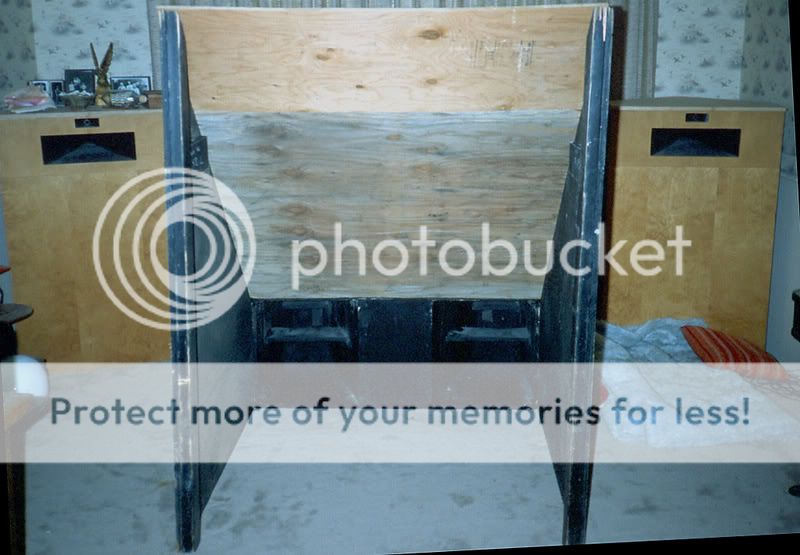
Amazing what my wife puts up with. It helps if you feed them ice cream.

Now I just fire it into a corner.
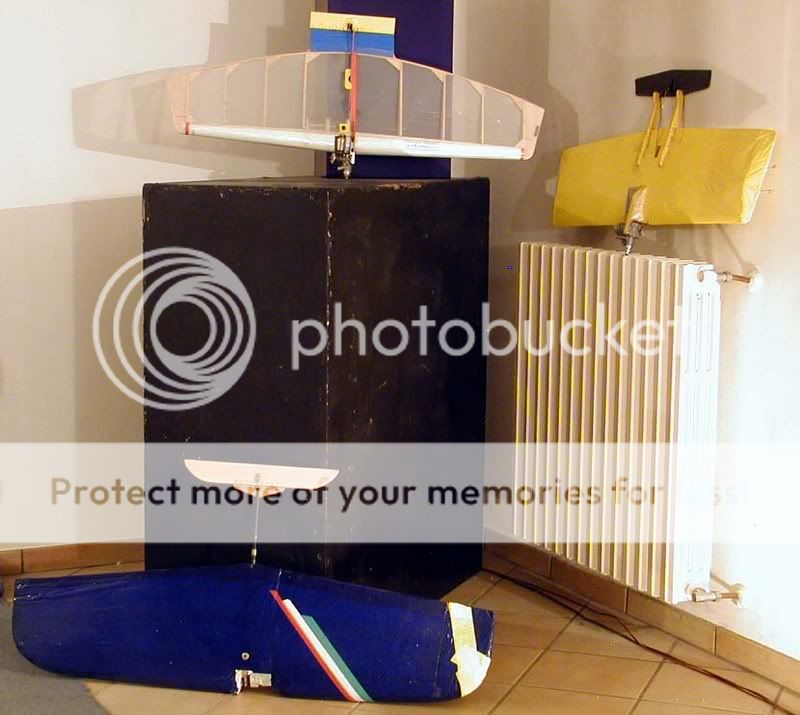
Can't help with the electronics, but the reason for the mouth extensions was to continue the horn flare in order to get down to ~16Hz. Small movie theaters used 4 subs, medium size used 8, and big theaters used 16.
Most of the rear subs fired into the rear corners, so used the walls to continue the flare. But they couldn't use the front corners because that's where the front fire escape doors were. So, they simply laid the front subs in a line across the front and used the mouth extensions for the flare.
I have one set of the originals. They're made from 3/4" plywood. I'll measure them tomorrow. Check these photos.

Amazing what my wife puts up with. It helps if you feed them ice cream.

Now I just fire it into a corner.

The Epicenter Bass Restoration Processor
If you are looking for electronics to enhance the low frequencies, then you might want to look at the Audio Control Epicenter signal processor. This was a popular piece in the car audio scene. The way I understand it, it samples the bass frequency content of the incoming signal and then synthesizes an additive signal that is an octave lower. So if you have some 35Hz bass coming through, it will add in some 17.5Hz information and sum it with the original signal. It is a 12VDC device, so you’ll need a 12VDC wall transformer to run it. You can also read the patent on it, it is patent number 4698842.
If you are looking for electronics to enhance the low frequencies, then you might want to look at the Audio Control Epicenter signal processor. This was a popular piece in the car audio scene. The way I understand it, it samples the bass frequency content of the incoming signal and then synthesizes an additive signal that is an octave lower. So if you have some 35Hz bass coming through, it will add in some 17.5Hz information and sum it with the original signal. It is a 12VDC device, so you’ll need a 12VDC wall transformer to run it. You can also read the patent on it, it is patent number 4698842.
.The Epicenter Bass Restoration Processor
If you are looking for electronics to enhance the low frequencies, then you might want to look at the Audio Control Epicenter signal processor. This was a popular piece in the car audio scene. The way I understand it, it samples the bass frequency content of the incoming signal and then synthesizes an additive signal that is an octave lower. So if you have some 35Hz bass coming through, it will add in some 17.5Hz information and sum it with the original signal. It is a 12VDC device, so you’ll need a 12VDC wall transformer to run it. You can also read the patent on it, it is patent number 4698842.
Look up DBX-120A Subharmonic Synthesizer
Dave
What's the point of the synthesiser? Have you actually seen the LFE content available in some movies?
The New Master List of BASS in Movies with Frequency Charts
The New Master List of BASS in Movies with Frequency Charts
Are you sure the efect hasn't been added to the commercial DVD releases of the movie?
According to this they made a mess of it and why he wants to make a transfer with the correct soundtrack: Amazon.com: P. T. Chamberlain's review of Earthquake
Hopefully, they will get it right for the BD release, but then it's Universal, so not holding my breath in anticipation.
GM
I know; the line before that you deleted in reply explained that you don't need the speakers at all to add LFE to a track these days, especially if it's something simple like switched BW limited random noise. You can do it on an average desktop PC with suitable authoring software and a suitable plug in or two.According to this they made a mess of it and why he wants to make a transfer with the correct soundtrack: Amazon.com: P. T. Chamberlain's review of Earthquake
FWIW, I'm all for him fixing up the track if it's not to par.
So you're saying that the mains and/or the LFE channel can be programmed to accurately 'clone' the signal that the outboard synthesizer generated to get the desired 'experience'?
While we're on the subject, I don't understand why 120 dB/16 Hz is needed since the original design spec'd the horns with a 15 Hz cutoff, ergo ~23 Hz is pretty much the lower limit the system can go with authority, which falls in line with what I've read/been told about the controller 'doubling' the soundtrack's 55-110 Hz BW to add ~22.5-55 Hz content.
Note too that the system was supposedly adjusted until an overall SPL of 95 dB (A scale) was achieved at the center of the theater, with no more than 110 dB (C scale) 4 feet in front of any horn, so again, where's the need for 120 dB/16 Hz to accurately replicate the original's experience?
Also, there's control tones at 25, 35 Hz, but it's not clear to me what these do or if they are even reproduced by the controller.
GM
While we're on the subject, I don't understand why 120 dB/16 Hz is needed since the original design spec'd the horns with a 15 Hz cutoff, ergo ~23 Hz is pretty much the lower limit the system can go with authority, which falls in line with what I've read/been told about the controller 'doubling' the soundtrack's 55-110 Hz BW to add ~22.5-55 Hz content.
Note too that the system was supposedly adjusted until an overall SPL of 95 dB (A scale) was achieved at the center of the theater, with no more than 110 dB (C scale) 4 feet in front of any horn, so again, where's the need for 120 dB/16 Hz to accurately replicate the original's experience?
Also, there's control tones at 25, 35 Hz, but it's not clear to me what these do or if they are even reproduced by the controller.
GM
Original Earthquake Sensuorround Subwoofers
Here's a pair that I have had for about 30 years.
These two subwoofers are fully functional and the speaker drivers are the original 189E 18". The cabinets have been upgraded for road travel.
My name is Harry Price. I live in Sacramento, California. These speakers are just sitting in my garage waiting for a purpose in life. Let me know if they are useful to someone. Thanks. -Harry Price harryguitarsolo@gmail.com
Here's a pair that I have had for about 30 years.
These two subwoofers are fully functional and the speaker drivers are the original 189E 18". The cabinets have been upgraded for road travel.
My name is Harry Price. I live in Sacramento, California. These speakers are just sitting in my garage waiting for a purpose in life. Let me know if they are useful to someone. Thanks. -Harry Price harryguitarsolo@gmail.com
Attachments
- Status
- This old topic is closed. If you want to reopen this topic, contact a moderator using the "Report Post" button.
- Home
- Loudspeakers
- Subwoofers
- Sensurround horns - any information please?
